
The Anacardiaceae, commonly known as the cashew family or sumac family, are a family of flowering plants, including about 83 genera with about 860 known species. Members of the Anacardiaceae bear fruits that are drupes and in some cases produce urushiol, an irritant. The Anacardiaceae include numerous genera, several of which are economically important, notably cashew, mango, Chinese lacquer tree, yellow mombin, Peruvian pepper, poison ivy, poison oak, sumac, smoke tree, marula and cuachalalate. The genus Pistacia is now included, but was previously placed in its own family, the Pistaciaceae.

Celtis is a genus of about 60–70 species of deciduous trees, commonly known as hackberries or nettle trees, in the hemp family Cannabaceae. It has a cosmopolitan distribution.
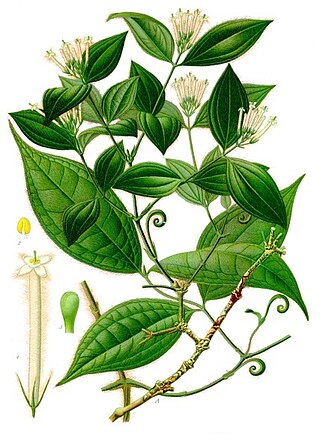
Strychnos is a genus of flowering plants, belonging to the family Loganiaceae. The genus includes about 200 accepted species of trees and lianas. The genus is widely distributed around the world's tropics and is noted for the presence of poisonous indole alkaloids in the roots, stems and leaves of various species. Among these alkaloids are the well-known and virulent poisons strychnine and curare.

Canarium is a genus of about 120 species of tropical and subtropical trees, in the family Burseraceae. They grow naturally across tropical Africa, south and southeast Asia, Indochina, Malesia, Australia and western Pacific Islands; including from southern Nigeria east to Madagascar, Mauritius, Sri Lanka and India; from Burma, Malaysia and Thailand through the Malay Peninsula and Vietnam to south China, Taiwan and the Philippines; through Borneo, Indonesia, Timor and New Guinea, through to the Solomon Islands, Vanuatu, New Caledonia, Fiji, Samoa, Tonga and Palau.

Ochna is a genus comprising 79 species of evergreen trees, shrubs and shrublets belonging to the flowering plant family Ochnaceae. These species are native to tropical woodlands of Africa, Madagascar, the Mascarenes and Asia. Species of this genus are usually called ochnas, bird's-eye bushes or Mickey-mouse plants, a name derived from the shape of the drupelet fruit. The name of this genus comes from the Greek word ὄχνη (ókhnē), used by Theocritus and meaning "wild pear", as the leaves are similar in appearance. Some species, including Ochna integerrima and O. serrulata, are cultivated as decorative plants.

Myrica is a genus of about 35–50 species of small trees and shrubs in the family Myricaceae, order Fagales. The genus has a wide distribution, including Africa, Asia, Europe, North America, and South America, and missing only from Antarctica and Oceania. Some botanists split the genus into two genera on the basis of the catkin and fruit structure, restricting Myrica to a few species, and treating the others in Morella.

Khaya is a genus of five tree species in the mahogany family Meliaceae. The timber of Khaya is called African mahogany, and is valued as a substitute to American mahogany.

Entandrophragma is a genus of eleven known species of deciduous trees in the family Meliaceae.

The Aponogetonaceae are a family of flowering plants in the order Alismatales.

Nepenthes madagascariensis is one of two Nepenthes pitcher plant species native to Madagascar, the other being N. masoalensis.
Isolona is a genus of flowering plants in the family Annonaceae. There are 21 species native to Africa. They occur in humid habitat types.

Olax is a plant genus in the family Olacaceae. It includes 52 species native to the tropics of South America, Africa, Asia, and Australia. The name derives from the Latin, olax (malodorous), and refers to the unpleasant scent of some of the Olax species. Olax is an Old World genus represented by several climbers, some species have leaves and fruits smelling of garlic such as Olax subscorpioidea and Olax gambecola, seeds of the latter are used as condiments in parts of West Africa. In India Olax nana is well known as one of the first species to emerge after forest fires, the shoots growing directly from buried roots.

Antiaris toxicaria is a tree in the mulberry and fig family, Moraceae. It is the only species currently recognized in the genus Antiaris. The genus Antiaris was at one time considered to consist of several species, but is now regarded as just one variable species which can be further divided into five subspecies. One significant difference within the species is that the size of the fruit decreases as one travels from Africa to Polynesia. Antiaris has a remarkably wide distribution in tropical regions, occurring in Australia, tropical Asia, tropical Africa, Indonesia, the Philippines, Tonga, and various other tropical islands. Its seeds are spread by various birds and bats, and it is not clear how many of the populations are essentially invasive. The species is of interest as a source of wood, bark cloth, and pharmacological or toxic substances.
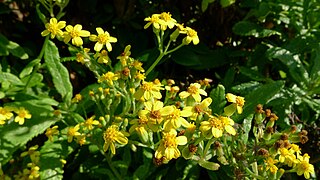
Senecio madagascariensis, also known as Madagascar ragwort, is a species of the genus Senecio and family Asteraceae that is native to Southern Africa. Other common names include Madagascar groundsel and fireweed. It has been included on the noxious weeds list for Hawaii and the reject list for Australia. S.madagascariensis is the diploid cytotype of S.inaequidens.
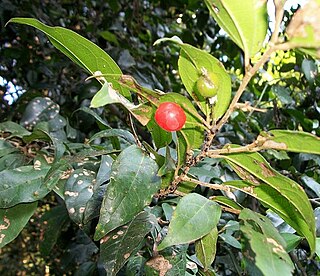
Celtis mildbraedii is a species of forest tree in the family Cannabaceae. It was previously assigned to the family Ulmaceae. These trees grow in limited areas of South Africa, Mozambique and Zimbabwe. They are also found in forested areas from West Africa to Sudan, DRC, Angola and Tanzania. Common names include natal white stinkwood, red-fruited white-stinkwood and natal elm. This species is more common in Tropical Africa than in Southern Africa.

Bobgunnia madagascariensis, also called the snake bean plant, is a species of legume in the family Fabaceae. Sometimes sold as "Pau Rosa", along with Bobgunnia fistuloides.
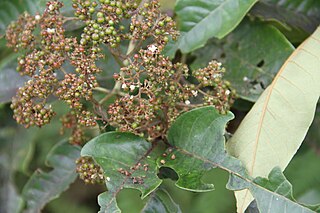
Harungana madagascariensis is a flowering plant found in Madagascar that is commonly known as the dragon's blood tree, orange-milk tree or haronga.
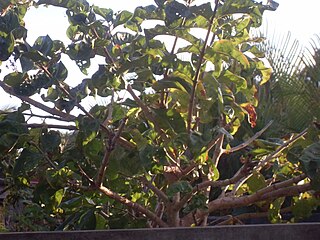
Vangueria madagascariensis, commonly known by the names Spanish-tamarind, tamarind-of-the-Indies, or voa vanga, is a species of flowering plant in the family Rubiaceae native to the African continent having edible fruit. It is the type species of the genus Vangueria and was described in 1791 by Johann Friedrich Gmelin.
Sopubia is a genus of flowering plants belonging to the family Orobanchaceae.

















